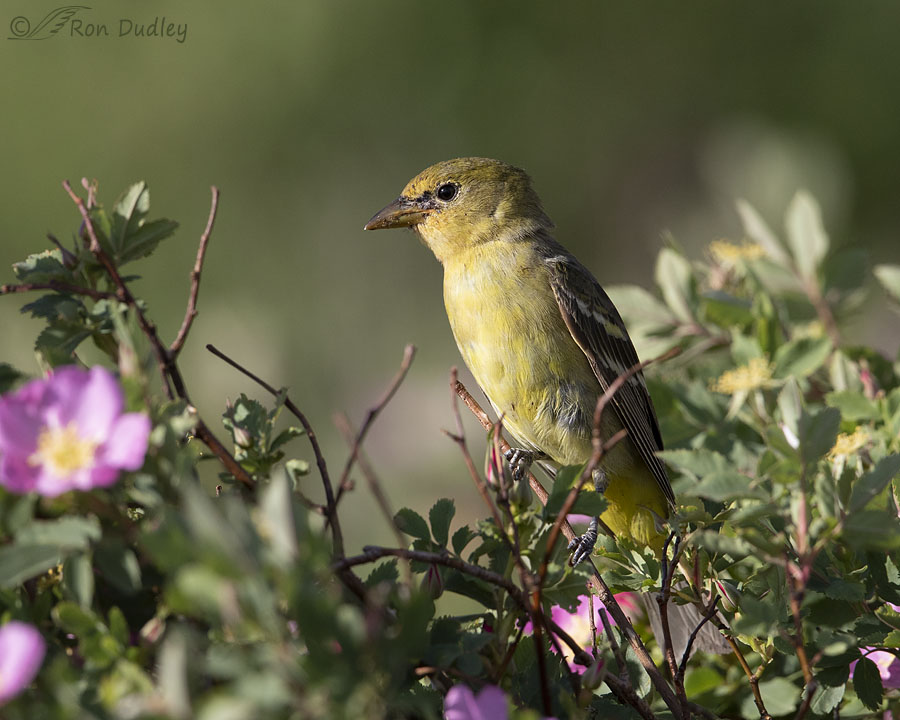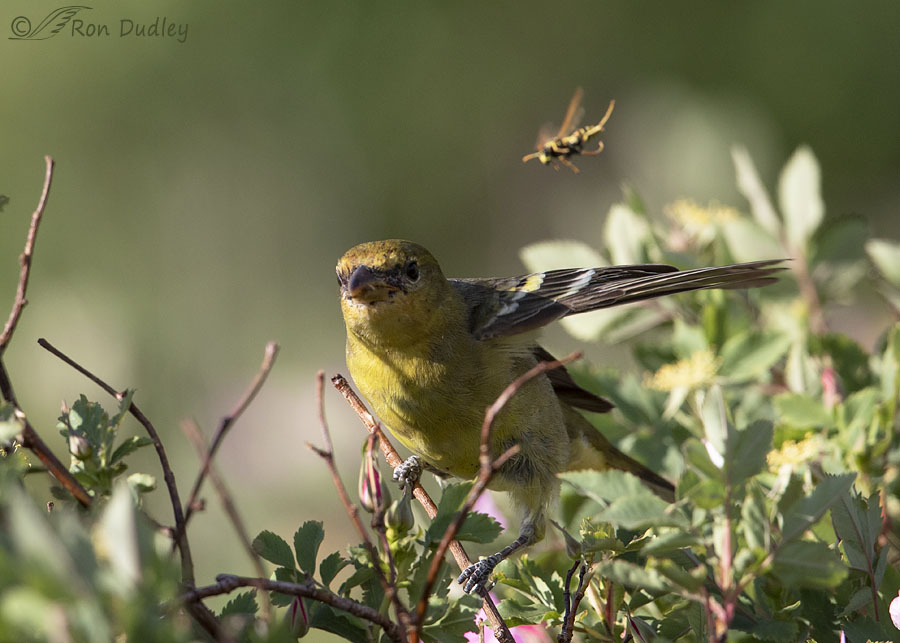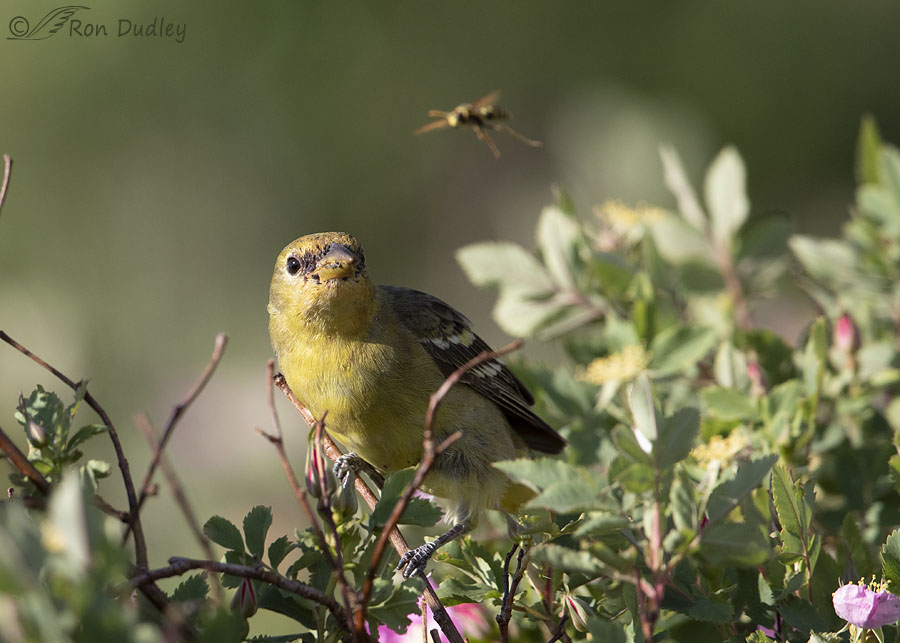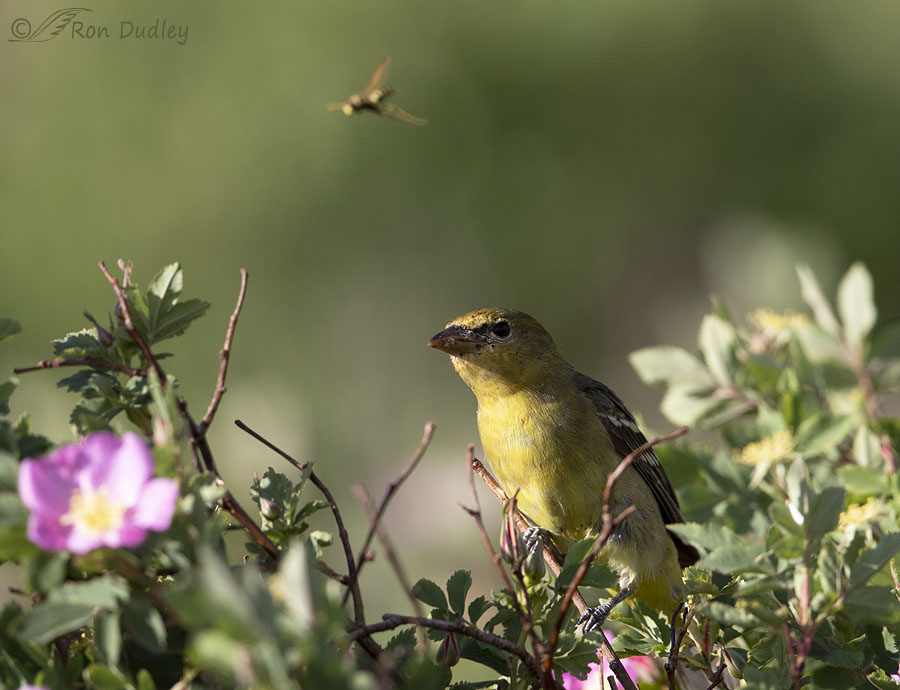A visitor to be wary of.

1/2000, f/6.3, ISO 500, Canon 7D Mark II, Canon EF 500mm f/4L IS II USM + EF 1.4 III Extender, not baited, set up or called in
Yesterday morning while I was photographing other songbirds in a remote area of northern Utah this female Western Tanager unexpectedly popped up out of a wild rose bush. Her appearance was a pleasant surprise because I had no idea she was even in the vicinity.
The bushes I had staked out for birds were a mix of wild rose and sumac and I’d been hoping that some bird, any bird, would land in the roses because the masses of flowers that had recently opened would make an attractive setting for my photos. But sadly, when the tanager appeared she was side-lit and the few flowers in my photos of her were mostly in the foreground and out of focus.
But suddenly another player appeared on the scene to make things more interesting for both bird and photographer.

1/1600, f/6.3, ISO 500, Canon 7D Mark II, Canon EF 500mm f/4L IS II USM + EF 1.4 III Extender, not baited, set up or called in
The menacing wasp came from out of nowhere and surprised us both. This was her reaction to its sudden appearance.

1/1600, f/6.3, ISO 500, Canon 7D Mark II, Canon EF 500mm f/4L IS II USM + EF 1.4 III Extender, not baited, set up or called in
Western Tanagers are primarily insect eaters and I’ve seen them eat large stinging insects with enthusiasm so I suspect her reaction was one of wary aggressiveness toward the wasp. She’d gladly take it as a meal but she also didn’t want to get stung.
But the wasp didn’t come in quite close enough for her to snag it out of the air so…

1/1600, f/6.3, ISO 500, Canon 7D Mark II, Canon EF 500mm f/4L IS II USM + EF 1.4 III Extender, not baited, set up or called in
all she could do was watch it eventually fly off.
I’m no entomologist and the insect is blurry in my photos but to me it strongly resembles a wasp. Please correct me if you confidently lean in a different direction.
Ron


Female Western tanagers have the sweetest faces! Love her look as she tries to figure out, “should I or shouldn’t I?”
Wonderful series! Nature is fascinating.
First photo is a beauty…subject, color, composition…..2,3,4 are drama…like them all….👍
Thank you, Patty.
Not only do I love the birds that you post I love the comments too.
Thank you – one and all.
I share your love of them both, EC.
Lovely photos, color and light is very rich. Mrs Tanager sure has a dirty face! She must be eating some kind of stick berry or flower.
I did not know how much tanagers liked wasps until I started weathering Western Tanagers for release from the rehab. The food we put out for the tanagers will attract yellow jackets, I watched as the tanagers would quickly grab and eat the yellow jackets that entered their cages. The birds are very adept,at catching and dispatching the wasps, they would pinch off the stinger and munch down the wasps. I started putting up yellow jacket traps and sometimes just wet cat foot out in their weathering cages to attract the yellow jackets. When I captured yellow jackets in the traps I would put it in the freezer for a few minutes to stun them and put them in a dish for the western tanagers. I could not believe how happy the birds were with their bowl full of wasps and they would quickly gobble down the wasps. For me it was a win, win deal. I got rid of nasty yellow jackets, the birds loved them and I saved money on buying mealworms!
That’s a neat story, April. Good for you for thinking of it. Triple wins don’t come around very often.
Hawks and eagles are the big, impressive birds that are often the subject of your blog. I love to see the smaller birds when you show them. It gives balance to your blog. And it gives me a chance to see birds that I have a harder time seeing than when younger–both because of my eyes and their decreasing numbers.
Nancy, I post what I shoot which tends to be more raptors for much of the year but in spring and summer I post more songbirds and wading birds.
Really do like the first photo even with out of focus flowers. Kind of agree with Judy on the ‘yellow jacket’ call and definitely one to be wary of. I’ve been swarmed by six and it was not a pleasant experience.
“I’ve been swarmed by six and it was not a pleasant experience”
Kathy, I’ve had similar experiences when I’ve been mowing my lawn. Gets your attention!
Yikes! Definitely get ones attention bird or human! Looks like what we refer to a a “yellow-jacket” but, at least here, it’s “early” for them.
Winter wheat mostly looking good – “shiny” – scruffy in fields that were sprayed before the storm but OK. Appears what “spring crop” we have in the area wasn’t up very far and the snow protected it. Wind and sun yesterday didn’t impress my perennials yesterday and had them drooping……
Judy, I also think it’s a Yellow Jacket but since Yellow Jackets are a type of wasp and I wasn’t sure I decided to go the generic route and just call it a wasp.
Wasp is good enough for me Ron. She definitely looks very surprised by the wasp’s sudden appearance.,but once over the surprise she certainly was not afraid. A couple years back we got a good look at birds eating insects. Very late in the fall a huge lost group of bees came and quickly developed a very large hive in our back yard. I called a bee keeper who came and sadly had to kill them because it was too late to move them. But before he came we had two Say’s Phoebes in the yard who would just fly over to the hive whenever they pleased to grab a bee snack.
Everett, I’m always surprised by how many birds take the risk of eating stinging insects. If they’re stung, that amount of venom for a bird that typically weighs many hundreds of times less than we do must be a shock to their system, at the very least.
The long dangling legs suggest that it’s a type of paper wasp. They’re not nearly as aggressive as yellowjackets.
Thanks for the ID tip, Carole.